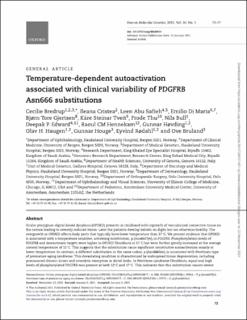| dc.contributor.author | Bredrup, Cecilie | |
| dc.contributor.author | Cristea, Ileana | |
| dc.contributor.author | Safieh, Leen Abu | |
| dc.contributor.author | Di Maria, Emilio | |
| dc.contributor.author | Gjertsen, Bjørn Tore | |
| dc.contributor.author | Tveit, Kåre Steinar | |
| dc.contributor.author | Thu, Frode | |
| dc.contributor.author | Bull, Nils | |
| dc.contributor.author | Edward, Deepak P. | |
| dc.contributor.author | Hennekam, Raoul C. | |
| dc.contributor.author | Høvding, Gunnar Jr | |
| dc.contributor.author | Haugen, Olav H. | |
| dc.contributor.author | Houge, Gunnar Douzgos | |
| dc.contributor.author | Rødahl, Eyvind | |
| dc.contributor.author | Bruland, Ove | |
| dc.date.accessioned | 2021-11-29T10:16:12Z | |
| dc.date.available | 2021-11-29T10:16:12Z | |
| dc.date.created | 2021-10-19T17:33:55Z | |
| dc.date.issued | 2021 | |
| dc.identifier.issn | 0964-6906 | |
| dc.identifier.uri | https://hdl.handle.net/11250/2831852 | |
| dc.description.abstract | Ocular pterygium-digital keloid dysplasia (OPDKD) presents in childhood with ingrowth of vascularized connective tissue on the cornea leading to severely reduced vision. Later the patients develop keloids on digits but are otherwise healthy. The overgrowth in OPDKD affects body parts that typically have lower temperature than 37°C. We present evidence that OPDKD is associated with a temperature sensitive, activating substitution, p.(Asn666Tyr), in PDGFRB. Phosphorylation levels of PDGFRB and downstream targets were higher in OPDKD fibroblasts at 37°C but were further greatly increased at the average corneal temperature of 32°C. This suggests that the substitution cause significant constitutive autoactivation mainly at lower temperature.
In contrast, a different substitution in the same codon, p.(Asn666Ser), is associated with Penttinen type of premature aging syndrome. This devastating condition is characterized by widespread tissue degeneration, including pronounced chronic ulcers and osteolytic resorption in distal limbs. In Penttinen syndrome fibroblasts, equal and high levels of phosphorylated PDGFRB was present at both 32°C and 37°C. This indicates that this substitution causes severe constitutive autoactivation of PDGFRB regardless of temperature. In line with this, most downstream targets were not affected by lower temperature. However, STAT1, important for tissue wasting, did show further increased phosphorylation at 32°C. Temperature-dependent autoactivation offers an explanation to the strikingly different clinical outcomes of substitutions in the Asn666 codon of PDGFRB. | en_US |
| dc.language.iso | eng | en_US |
| dc.publisher | Oxford University Press | en_US |
| dc.rights | Navngivelse-Ikkekommersiell 4.0 Internasjonal | * |
| dc.rights.uri | http://creativecommons.org/licenses/by-nc/4.0/deed.no | * |
| dc.title | Temperature-dependent autoactivation associated with clinical variability of PDGFRB Asn666 substitutions | en_US |
| dc.type | Journal article | en_US |
| dc.type | Peer reviewed | en_US |
| dc.description.version | publishedVersion | en_US |
| dc.rights.holder | Copyright 2021 the authors | en_US |
| cristin.ispublished | true | |
| cristin.fulltext | original | |
| cristin.qualitycode | 2 | |
| dc.identifier.doi | 10.1093/hmg/ddab014 | |
| dc.identifier.cristin | 1947116 | |
| dc.source.journal | Human Molecular Genetics | en_US |
| dc.source.pagenumber | 72-77 | en_US |
| dc.identifier.citation | Human Molecular Genetics. 2021, 30 (1), 72-77. | en_US |
| dc.source.volume | 30 | en_US |
| dc.source.issue | 1 | en_US |

